
Increasing amounts of carbon dioxide in the atmosphere, mostly from humans burning fossil fuels, are contributing to warmer global temperatures and climate change. This rise in the average temperature of the land and water on Earth has contributed to melting glaciers, rising sea levels, and longer and more intense wildfire seasons, among other environmental impacts.
What does this have to do with forests? It turns out the plants and trees in forests, and the wood products that come from them, can help fight climate change. Trees are great at pulling atmospheric carbon out of the air. The best part is that carbon stays locked up long after a tree is used to make buildings, furniture or hundreds of other wood products.
In fact, the total carbon sequestered in Oregon by our forests and the wood products made here is estimated to be 49.5 million metric tons of carbon dioxide equivalent each year, according the Oregon Forest Resources Institute report Carbon in Oregon’s Managed Forests.
Authored by experts in carbon and forestry as well as the life cycle assessment of wood products, the 120-page report and an accompanying 12-page summary highlight the major role Oregon’s forests play in keeping carbon out of the atmosphere, underscoring the importance of using strategies that enhance these forests’ carbon-sequestering superpowers to combat climate change.
Learn more by reading:
Carbon in Oregon’s Managed Forests – Summary Report
Carbon in Oregon’s Managed Forests – Science Review on Carbon, Managed Forests and Wood Products
It starts with photosynthesis
Forest carbon sequestration starts with photosynthesis, the process plants use to take carbon dioxide out of the atmosphere. Chloroplasts inside leaves and needles use carbon dioxide from the air, water from the soil and energy from sunlight to produce glucose, a simple sugar. Trees use glucose to make wood, storing solid carbon in the process. Oxygen is released into the atmosphere as a byproduct.
This simplified chemical equation shows how carbon atoms from the carbon dioxide molecules are moved to glucose molecules through the process of photosynthesis.
Carbon in Oregon's forests
During photosynthesis, trees absorb carbon dioxide from the atmosphere. They then turn the carbon dioxide into solid carbon. This is stored in wood and throughout the forest in carbon “pools.” These include:
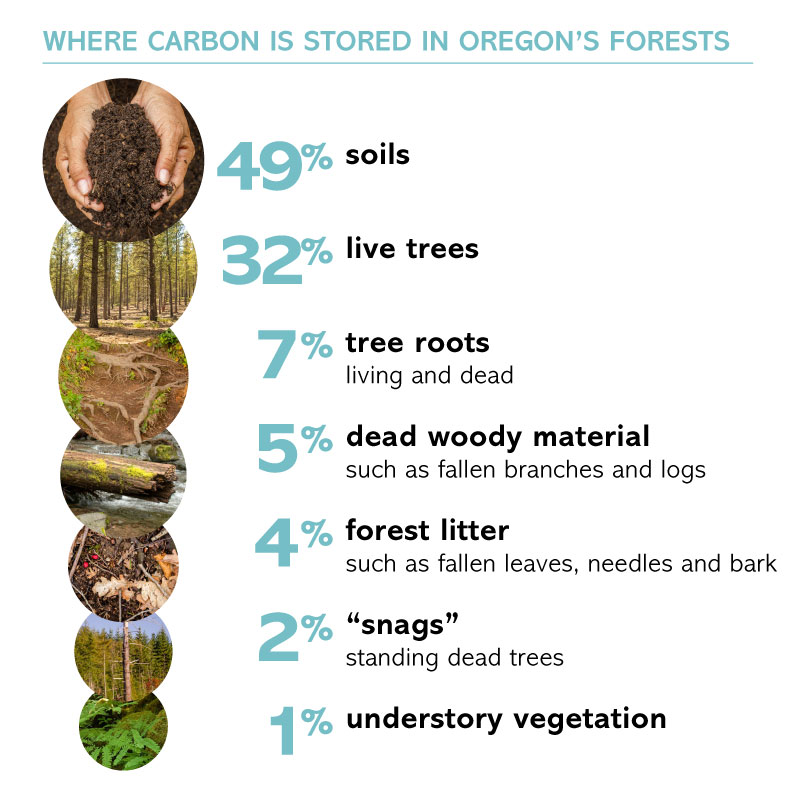
Most of this carbon stays out of the atmosphere, even after a tree is cut down and the wood is used to build something. About half the dry weight of wood is carbon, which remains stored in wood products used to construct houses, apartments and office buildings, and helps offset carbon emissions that are contributing to climate change.
How much carbon is stored in Oregon's forests?
With the help of measurements taken in the field, scientists can estimate the amount of carbon physically present in Oregon’s forests by the pool it’s located in, such as the amount of carbon stored in live trees. Total forest carbon is the sum of the carbon stored in all a forest’s carbon pools.
Carbon can move between various forest pools and eventually be released back into the atmosphere, in a process known as “carbon flux.” That means that although forests amass large quantities of carbon as trees grow, they don’t store carbon indefinitely. When trees die and start to decay, for instance, they release carbon.
The most recent comprehensive analysis of how much carbon is stored in Oregon’s forests was conducted by the U.S. Forest Service’s Forest Inventory and Analysis (FIA) program at the Pacific Northwest Research Station, in partnership with the Oregon Department of Forestry (ODF). It used field measurements taken between 2001 and 2016.
For the 10-year reporting cycle between 2007 and 2016, the FIA-ODF carbon inventory estimates there are approximately 3.2 billion metric tons of carbon stored on both public and privately owned Oregon forestland in all carbon pools, including the forest floor and soils.
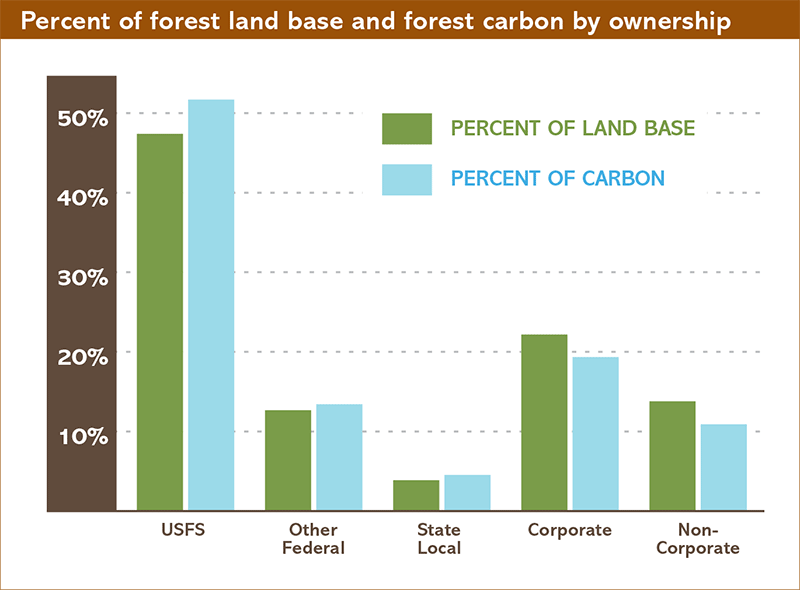
There is a close relationship between the proportion of Oregon forestland that falls under each type of ownership and how much carbon is stored there. For instance, the national forests, which are managed by the U.S. Forest Service and account for just under half of Oregon’s forestlands, are storing slightly more than half the state’s forest carbon.
Maximizing forests' carbon-storing potential
Scientists around the world have been studying the role forests can play in mitigating climate change. The Intergovernmental Panel on Climate Change, a United Nations body responsible for assessing international science related to climate change, has recognized the importance of using sustainable forest management practices that enhance forests’ natural abilities to sequester carbon, as well as the increased use of wood products to help reduce carbon dioxide emissions.
Given the capacity of forests to capture and store carbon in the ecosystem and wood products, the timber industry is frequently discussed as a critical component of reducing atmospheric carbon. And Oregon – with its abundant, fast-growing forests and status as the top U.S. producer of softwood lumber – is well situated to contribute.
Oregon’s managed forests already sequester and store significant amounts of carbon, but there are a number of ways they can further contribute to reducing atmospheric carbon. These include preventing the conversion of forestland to other uses, such as housing or other urban development, as well as decreasing the risk of high-severity wildfires and insect or disease outbreaks that can kill large numbers of trees.
Planting trees to create more forests would help take even more carbon dioxide out of the atmosphere. Active forest management aimed at improving a forest’s overall health and productivity, as well as resilience to wildfires, can help it capture and store even more atmospheric carbon. Letting trees grow to their peak carbon-storage age before harvest can also increase the carbon stored in existing forests and forest products, although there would be financial trade-offs with this strategy for landowners who primarily manage their forests for timber production.
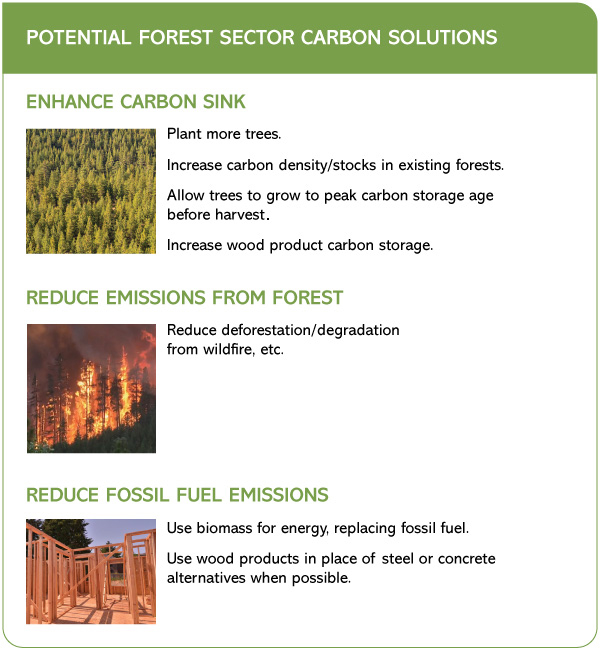
There are many ways Oregon’s forest sector–the part of the state economy that’s derived from forests–can be part of the solution in the fight against climate change.
Retaining forests is important to fighting climate change
Forests in the United States serve as a “carbon sink,” offsetting approximately 10 to 20 percent of the country’s carbon emissions from burning fossil fuels each year, according to the U.S. Forest Service. This underscores the crucial role of forests in capturing and storing atmospheric carbon into the future.
The significant conversion of forestland to agriculture and urbanization – particularly rainforests in tropical regions – has affected our climate. Fortunately, Oregon has done remarkably well in protecting forests from development. The state retains 92 percent of the forest cover that was present in 1850.
One reason the amount of forestland in Oregon has remained steady is because many private landowners have an economic incentive to preserve forests for timber production. This means they’re less likely to sell forestland for development into housing or other uses. Landowners are also required by Oregon law to replant trees after a timber harvest, ensuring these forests will remain forests into the future.
Using wood reduces carbon footprints
Carbon storage is one reason wood is a more environmentally friendly building material than concrete and steel, which require more energy and water to produce, and also create large amounts of carbon dioxide during the manufacturing process.
Wood performs well in life cycle assessments (LCAs), a method of tracking the overall environmental impact of a product–from the extraction of the raw materials used to make it through to the product’s disposal. LCAs have shown that making wood products typically consumes far less water, and requires far less energy and therefore generates fewer carbon emissions, than producing other construction materials.
As a result, timber construction reduces the overall carbon footprint of a building project, both through carbon storage and by substituting wood for more energy-intensive materials. Replacing concrete and steel can also offset decades of carbon emissions from heating, cooling and powering the building. As advances in technology make it possible to build increasingly efficient buildings, using wood can actually result in a negative carbon footprint over the life of the structure.
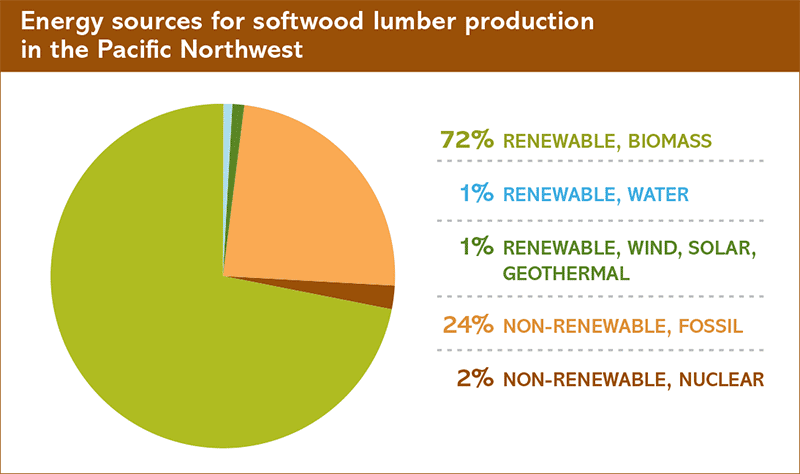
One advantage of wood from a carbon emissions standpoint is that manufacturing wood products requires less energy than other materials. For Pacific Northwest lumber mills, most of that energy comes from renewable sources, primarily from using wood residuals from the milling process to generate biomass energy.
Markets for forest carbon
Forests’ vital role as a natural mechanism to remove and store carbon from the atmosphere makes them a crucial part of mitigating climate change. U.S. forests and associated wood products currently capture and store 16% of the country’s annual carbon dioxide emissions from burning fossil fuels. Carbon markets that incentivize landowners to take steps through carbon offset projects that increase carbon storage on their forests – while providing a range of social and environmental co-benefits such as wildlife habitat – help take advantage of these forests’ climate mitigation abilities.
Sustainably managing forests has been recognized as a relatively cost-effective strategy for offsetting greenhouse gas emissions. Nature-based solutions can help absorb about a third of the carbon pollution produced in the U.S., according to research led by The Nature Conservancy. These solutions include reforestation, practices that improve soil health, and forest carbon management.
U.S. forests have the potential to store even more carbon through enhanced forest management practices. Some of the greatest opportunities to sequester and store more carbon are on America’s private, family-owned forestlands. By managing just 20% of family-forest acres in the U.S. with practices that increase carbon sequestration by 2030, approximately 3.5 trillion metric tons of carbon dioxide could be sequestered by the end of the century.
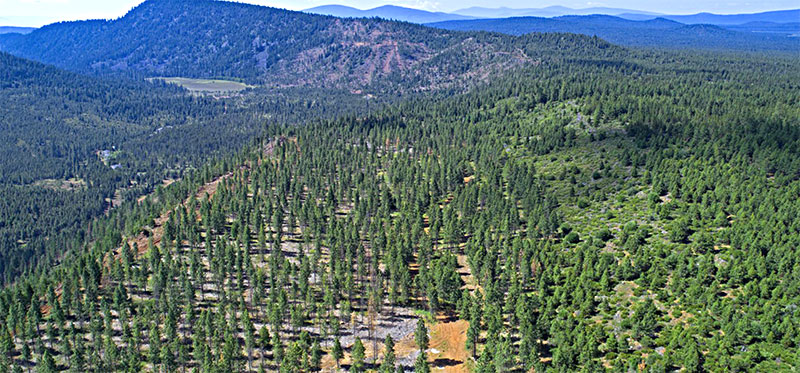
Green Diamond Resource Co. forestland near Klamath Falls is being managed for carbon sequestration and storage as part of a registered carbon offset project. (Photo courtesy of Stacy McNeil, Green Diamond Resource Co.)
Learn more by reading:
Carbon in Oregon’s Managed Forests – Summary Report
Carbon in Oregon’s Managed Forests – Science Review on Carbon, Managed Forests and Wood Products